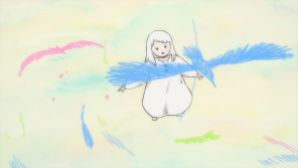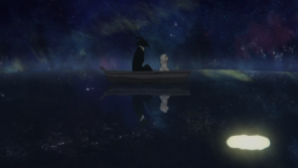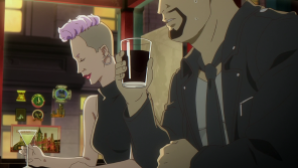Animation Production: Science Saru ( Devilman Crybaby / Eikouzen!, Lu Over the Wall, Super Shiro, The Night is Short, Walk on Girl])
Director: Masaaki Yuasa ( Director on the following works, Anime Rakugo Kan OAV / Devilman Crybaby, Kaiba, Eikouzen!, Kemonozume, Kick-Heart, Lu Over the Wall film, Mind Game film, Night is Short Walk on Girl film, Ping Pong The Animation, Ride Your Wave, Super Shiro, The Tatami Galaxy, Vampiyan Kids)
Sceenplay: Reiko Yoshida ( Script for the following works: Aokana: Four Rhythm Across the Blue, Arte, Bakuman, Buddha film series, Cheery Boys!!, Chu-Bra!!, D.Gray-man, Hakumei and Mikochi, Hanayamata, High School Fleet, Jyu-Oh-Sei, Kaleido Star, Liz and the Blue Bird film, Lu Over the Wall film, Orphen [2020 version] / Tamako Market / Tokyo Mew Mew / Violet Evergarden {8 episodes})
Original Creator: Masaaki Yuasa
Character Designer: Takashi Kojima ( Key Animation on Aikatsu’s 2nd Opening Sequence / Key Animation on Bakemonogatari Episodes 13 and 15 / Key Animation on Blood-C The Last Dark [film] / Music Producer on To Aru Kagau no Railgun S / Key Animation on Eureka Seven Ao’s first ending sequence / Character Designer and Chief Animation Director on Flip Flappers / Key Animation on Sakamichi no Apollon (Kids on the Slope) Episode 12 / Key Animation on Japan Animator Expo Episode 8 “Tomorrow from there” / Character Designer and Chief Animation Director on Ride Your Wave / Key Animation on Shangri-La / Key Animation on Space Dandy Episodes 5 and 12 / Music Producer on Strike the Blood / Episode Director, Animation Director, Composite, Key Animation, and Layout on Shigatsu wa Kimi no Uso (Your Lie in April) Episode 5 / Key Animation on Yuri Kuma Arashi)
Music: Michiru Oshima [Music Composer for the following works: Arc the Lad, Aura: Koga Maryuin’s Last War / BECK: Mongolian Chop Squad Episodes 11, 12, 17, 18, and 20 / Zetsuen no Tempest / Boys Over Flowers / Buddha films / Casshan: Robot Hunter Casshern OAVs / Le Chevalier D’Eon / Fancy Lala / FullMetal Alchemist original series / Fuse: Memoirs of a Huntress film / Gokusen TV-Live Action / Haikara-san trilogy films / Hal film / Kaze no Tairiku (The Weathering Continent) / Yagate Kimi ni Naru / Legend of Crystania / Little Witch Academia / Maho Tsukai Tai! (Magic User’s Club!) / Massage ni Iko / Nabari no Ou / The Night is Short Walk on Girl / Patema Inverted (film) / Pretty Guardian Sailor Moon (Live Action film) / Project Blue Earth SOS / / Ride Your Wave / Queen Emeraldas / Rokka no Yuusha/ Akagami no Shirayukihime (Snow White with Red Hair) / Sora no Wo To (Sound of the Sky) / Speed Racer X / The Tatami Galaxy / X’amd Lost Memories]
Last week I got a chance to see the U.S. premiere event screening of Masaaki Yuasa’s latest film Ride Your Wave. I can’t stop thinking about this film and the life lessons it presents to us. I’ve been a fan of Yuasa’s works for a long time, really since Kemonozume aired back in 2006, and I am glad to see him churning out projects one after the other. With his recent spotlight with Devilman Crybaby on Netflix I am glad to see he’s gaining more attention with his creative ideas about telling a story. I believe that this is one of the most important films of 2019/2020 because of its bittersweet take on love, grief, and moving on from your weaknesses, challenging yourself, and finding your inner strength make a life that is important to yourself.
Yuasa’s style is usually strange visuals matched with strong and varied stories. From a swordsman falling in love with a woman that’s secretly a man-eating ogre, a high-schooler’s admiration of ping-pong, to all the different possibilities a college-aged youth can have in creating their future, and of course a man turning into a devil finding purpose in a world slowly crumbling into madness.
Ride Your Wave is a treat because it is a departure from everything he’s done before. The story of young woman, Hinako Mukaimizu moving to the oceanside to attend college and surf. Getting accustomed to her new life and new apartment -cooking and figuring life for herself. Not long after living life in her apartment a fireworks show causes a fire and destroys her place. She is saved by firefighter Minato Hinageshi and her world opens up with love in her heart.
Ride Your Wave is just as much a story about love as much as it is about the defining moments in our lives. How the time we spend with others can mean something much larger. The experiences we have, whether they are happy or sorrowful can carry us into different directions in life. This film illustrates that life is like the waves of an ocean–coming and going but it is what we do with what we have learned through our experiences to establish a future for ourselves. A self-discovery story about losing a loved one and finding strength to carry on. Even if you haven’t seen this film and seen the trailer then you will know that Minato is killed in an accident at sea. For much of the first part of this film we get a well-written romantic comedy as we see Minato and Hinako falling in love, and for Hinako she’s beginning to find herself pretty well satisfied with life. Minato has carved his path out already in life–he’s a firefighter, and has learned a lot about cooking, etc. How to be independent. Hinako is very different in that she can’t cook, and hasn’t put much thought into what she wants to do in college. As she learns more and more about him she falls harder in love with him. This eventually plays a large role in Hinako’s self-discovery moments towards the later portion of the film as she learns of why she has always been important to him.
Within the first ten minutes I would have thought Hinako’s love interest would be the other firefighter, Wasabi Kawamura, a man that loves her and wants to prove his worth. Even after Minato has died, he opens up to her and getting through to her broken heart. I am extremely glad to see how they handled his character throughout the film–he evolves into this motivating figure for Hinako and it’s refreshing. As the same with Minato’s sister, Yoko Hinageshi. Really glad to see how they handled her dynamic with Hinako by using her rough attitude as a coping mechanism over her brother’s death. Apart from the great story and visuals the acting in this is superb! Rina Kawaei (Hinako) and Ryouta Katayose (Minato) [which these two actors haven’t had much in their repertoire] immerse themselves in their roles wonderfully and it pays off perfectly throughout the entire film!
Ride Your Wave focuses on the importance of moving forward when we go through hardship. Hinako discovers her boyfriend has died and she doesn’t know what to do. I won’t spoil much here but the entire animation sequence at the beach was handled perfectly. That very next scene is absolutely incredible because it shows us how defeated she is. Moving away from the place she finds joy (the sea), and the person that made her find purpose in her life is gone she is left shattered. She runs away from her life rather than confronting it head on. Avoiding all contact with her family and her friends. The fantasy aspect of this film firmly builds itself up in Yuasa-style in a charming bittersweet way. Hinako can see her boyfriend, Minato only if she sings the film’s theme song” Brand New Story” he appears through water. Time cut short with his life but now the two, both in different worlds, can reach their love with one another.
Something that Yuasa does really well is focusing on visuals rather than dialogue. We see their relationship grow and how water brings them closer together. The small vignettes of their dates illustrates this wonderfully- they’re at karaoke drinking water, they go swimming together where Hinako teaches Minato how to surf, and down to the romantic final moments of Minato’s life with her. The sheer amount of detail in this film impressed me–especially where we get long closeup shots of omurice being prepared and coffee being poured though a filtered. Depicting how important water is in this story. I am glad this film didn’t skip out on Minato’s life because we get this concrete view of why he is so hard working and what motivates him. His dream of owning his own coffee shop What’s important is that Minato wants Hinako to learn to be independent–ride the waves herself. Coming to terms with his death is the hardest thing to do for Hinako and that final scene at the park lands a huge impact for this film as a whole. She hasn’t gotten over him and his love for her is what gives her the strength to find a life for herself.
Devilman Crybaby, Kemonozume, Ping-Pong the Animation (which you can read my review here) , the Tatami Galaxy, if you have seen any of director Masaaki Yuasa’s series then you will know you are in for a treat. This film wouldn’t have made the impact it did without Yuasa’s charm to it– Ride Your Wave is an astonishing character study with a wildly experimental visual presence. Hinako is a character that we see carrying a lot of self-doubt in herself and it isn’t until she meets Minato–his selfless devotion towards helping others that gives Hinako a strength that she never knew she had.
Much of Yuasa’s works have this edge to them but this film shy’s away from that and goes for a soft feel to it and the coloring is more polished with its characters and its backgrounds. I really like what they’ve done with this film. With a gorgeous visual presentation and enriching score, bu the talented Michiru Oshima everything flows together wonderfully.
You will laugh, you will cry, you will see what Hinako is going through in her life and what a journey it is. Masaaki Yuasa is one of my favorite directors in the anime industry (especially since Tatami Galaxy is in my Top 10 best series), he’s able to create these stories that carry a wild ride of fun and still contain crucial bittersweet moments. Ultimately, making the important aspects of this film that centers around love and grief hold a heavy emotional impact to them .
A lot of surreal works from The Night is Short, Walk on Girl and the 2004 film Mind Game, Yuasa established an aesthetic that can only be done through animation. Quick flowing movements of characters that stretch and bend to illustrate emotional expression that’s situational or motives of its characters. Watching this film made me realize how they took Lu Over the Wall‘s central ideas about Lu being called out of the sea through music and absolutely mastered it with this animated feature. With Ride Your Wave, Hinako singing their song (Band New Story) with the focus on water— brings Minato back to life to embellish their love in a beautifully imaginative world of wonder. A world Hinako wishes she could live in forever and ever. And I’m sure the viewers want to as well. I know I did. It isn’t until you see the final minutes of the film that the importance Minato’s death, Hinako’s grief, and learning about his life being saved has to the overall story. Gaining independence and the confidence in herself to ride the waves that she’s made for herself.
By far, this is one of his best works to date, and I am happy to say is in my Top 10 Best Anime Films.
OVERALL IMPRESSIONS: [99/100]
—

















































